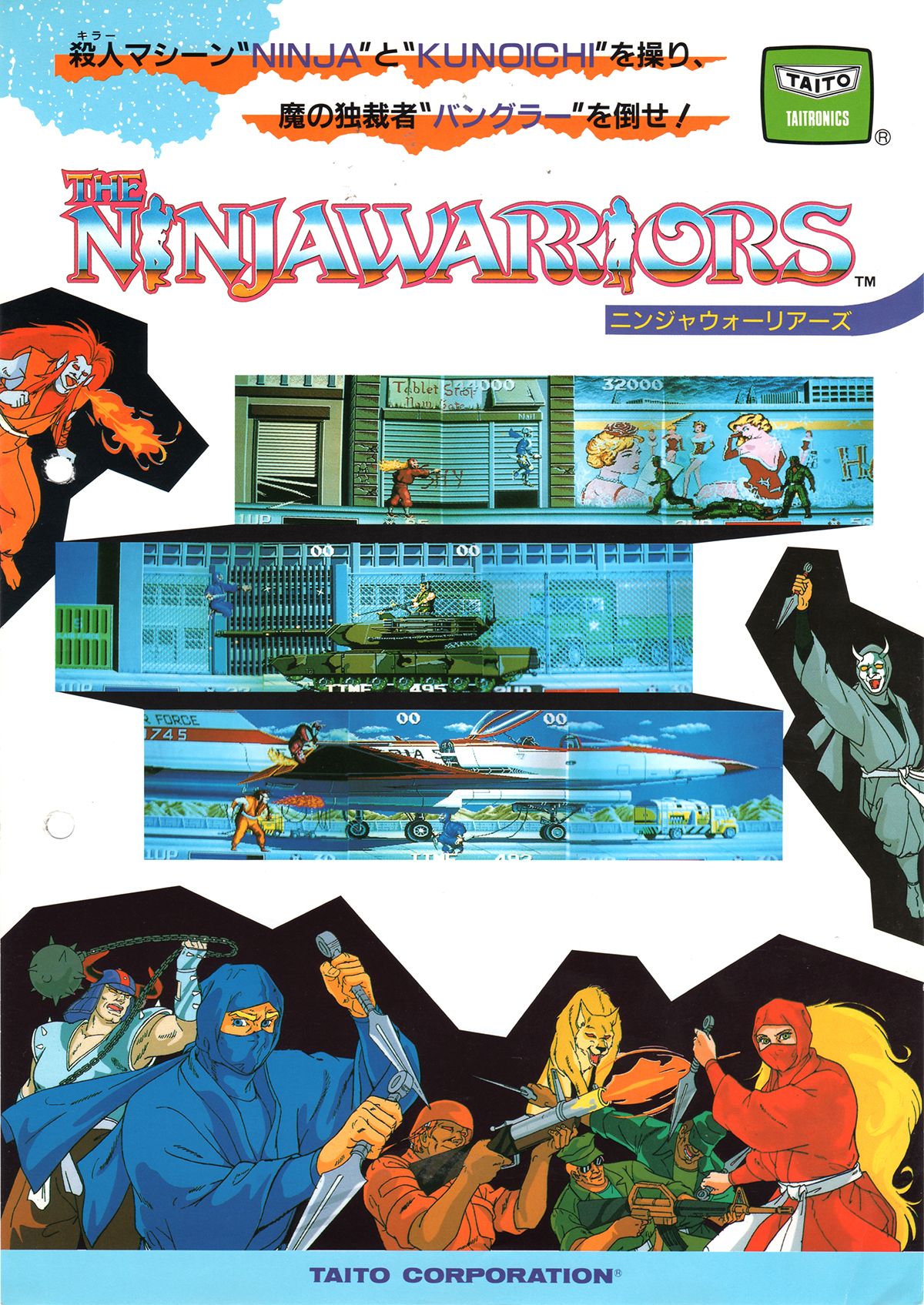忍者戰士
《忍者戰士》是Taito於1988年推出的橫向卷軸動作遊戲,它以當時極為罕見的三螢幕大型體感機台而聞名,也是繼《Darius》之後再次運用三螢幕寬畫面的雄心之作。以黑暗的近未來為舞台,將硬派的動作、壓迫感十足的敵襲與濃厚的反烏托邦情緒融合在一起,成功打造出80年代街機時代最具代表性的科幻忍者作品之一。
舞台設定發生在1993年的架空世界,一個曾經繁榮的大國因獨裁者「巴ングラー(Banglar)」以邪惡力量奪取總統之位後而陷入崩壞。罪惡與洗腦籠罩全國,人民在高壓統治下失去自由意志。革命軍領袖「馬爾克(Mulk)」深知以凡人之身無法對抗整個國家軍事力量,因此決定秘密打造兩名以忍者為原型的殺人機器人:身形敏捷的女性型號「KUNOICHI」與力量型男性「NINJA」。這兩名仿生忍者成為推翻獨裁政權的最後希望,於是,一場刺殺暴君的行動就此展開。
可以選擇操控KUNOICHI或NINJA,在城市、軍事基地、地下水道與巴ングラー官邸等六大關卡中一路挺進。操控方式採用最經典的街機配置——八方向搖桿搭配兩個按鈕。主要武器是近距離使用的「苦無」,能以高速斬擊清除接近的敵人;遠距離則可投擲手裏劍,但數量有限,必須靠擊敗忍者類敵人或通關補充。當每次遭受攻擊,角色外層的忍者服會被擊碎,露出機械本體,而露出的部分將在後續攻擊中承受加倍傷害,這讓玩家在推進關卡時必須格外小心,每一次失誤都可能放大成致命危機。
整體的動作節奏緊湊,敵人從左右兩側不斷包夾,需要靈活運用跳躍、斜向攻擊、甚至「回轉跳躍」去閃避火力。回轉跳躍讓角色在空中維持長時間無敵狀態,是避免被圍攻與靠身位反擊的核心技巧。同時,苦無長按可進入交叉格擋姿勢,能防禦手裏劍、子彈與匕首等攻擊,但不能阻擋火焰或爆炸。遊戲節奏雖快速,但戰略性極高,玩家必須在進攻、防禦、位移間取得最佳節奏。
敵人種類多樣且各具威脅性,從一般步兵、狙擊手、爆破兵,到具特殊能力的忍者,如吐火的火炎忍者、會滑翔的ムササビ、會模仿玩家動作的シャドーマン,以及以鐵球與鎖鎌攻擊的強敵「Iron Arm」。每一關的地形與敵配置都旨在讓玩家逐漸被壓迫到極限,再以高難度的敵軍密集攻勢逼出玩家的極限反應。遊戲中期還會出現從畫面外開進來的戰車,必須抓準機會用手裏劍精準命中機槍手才能擊破;而最後關卡的巴ングラー官邸更是步步殺機,充滿狹窄走道與致命的機械守衛。
三螢幕巨型街機機台本身也是這款遊戲的特色之一。它擁有與《Darius》相同的「體震座椅」設計,低頻重音會從座椅下方震動傳遞,營造強烈臨場感;搭配 ZUNTATA 的小倉久佳(OGR)所作的電子音樂,舞台展現出近未來、粗獷又冷酷的氛圍,其中Stage 1與Stage 6的名曲〈DADDY MULK〉更因融入津輕三味線取樣而成為遊戲史上非常獨特的音樂代表作。
自’推出後在日本與歐美的街機市場上都獲得高度評價,被多家遊戲媒體讚譽為技術創新、畫面寬度與音效表現皆達當時頂尖水平的作品。1988年在《ゲーメスト》大賞中拿下多項提名,包括最佳VGM第一名、最佳結局第二名,並在排行榜上位居高點。歐美家用機移植版則因8位與16位機能差異而出現品質不一的情況,但Amiga、Atari ST與PC Engine的版本仍獲得不錯的評價。
隨著時間推移,本作的影響力延伸至後續作品,包括1994年由Natsume製作、使用全新畫面與更精緻系統的《忍者戰士 Again》(The Ninja Warriors Again),以及 2019 年的高畫質強化版本《The Ninja Saviors: Return of the Warriors》,都延續本作的精神與硬派動作風格,使其成為橫向清版動作遊戲史上不容忽視的重要一章。
《忍者戰士》之所以能被視為經典,不僅因為其流暢扎實的玩法與音樂,更因其強烈的主題與設定:兩名忍者型機器人挑戰整個暴政國家的孤高與悲壯,使得玩家在橫向清殺的快感中,能體會到壓迫與反抗交織的深層張力。它是80年代街機文化最具代表性的象徵之一,至今仍被玩家懷念,並被視為三螢幕街機時代的殿堂級作品。
The Ninja Warriors, developed by Taito and released in 1988, is a side-scrolling action game famous for its rare triple-screen arcade cabinet—an ambitious display system previously used only in Darius. Set in a dark near-future, the game blends gritty action, oppressive enemy assaults, and a strong dystopian tone, becoming one of the most iconic sci-fi ninja titles of the 1980s arcade era.
The story takes place in an alternate 1993, where a once-prosperous nation has collapsed after the dictator Banglar seized the presidency through sinister powers. Under his rule, the population is brainwashed and stripped of free will. Knowing ordinary humans cannot stand against a militarized dictatorship, rebel leader Mulk secretly constructs two humanoid ninja assassin robots: KUNOICHI, an agile female-type unit, and NINJA, a powerful male-type model. These two bionic warriors represent the final hope of overthrowing Banglar’s tyrannical regime, and thus begins a mission of infiltration and assassination.
Players control either KUNOICHI or NINJA across six major stages, including city streets, military installations, underground tunnels, and Banglar’s heavily guarded mansion. Controls follow classic arcade simplicity: an eight-way joystick and two action buttons. Their primary weapon is the close-range kunai, capable of clearing enemies with rapid slashes. For long-range combat, players can throw limited shuriken, replenished by defeating certain foes or clearing stages. Each time the player character takes damage, their outer ninja suit tears away, exposing robotic parts that will take increased damage in subsequent hits—making cautious, precise play essential, as small mistakes quickly turn dangerous.
The game’s pacing is intense. Enemies swarm from both sides of the screen, requiring players to master jumping, diagonal strikes, and the crucial spinning jump, which grants temporary invulnerability and serves as a lifeline when surrounded. Holding the attack button triggers a cross-block stance that can deflect shuriken, bullets, and daggers—though not fire or explosions. Despite its fast tempo, the game demands strategy, rhythm, and timing between offense, defense, and evasive movement.
Enemy variety is one of the title’s strengths. Beyond foot soldiers, snipers, and bombers, the game features specialized ninja foes: fire-breathing Flame Ninjas, gliding Musasabi assassins, the mimic-like Shadow Man, and heavy hitters like Iron Arm with his iron ball and chain. Mid-game battles escalate further with tanks entering from off-screen, which players must disable by landing precise shuriken hits on the gunner. Banglar’s mansion, the final stage, is a claustrophobic gauntlet of traps and lethal mechanized guards.
Equally legendary is the game’s triple-screen arcade cabinet. Like Darius, it featured a vibrating “body-sonic” seat that transmitted low-frequency rumble through the player’s body, dramatically enhancing immersion. The experience was heightened by the electronic soundtrack composed by Hisayoshi Ogura (OGR) of ZUNTATA. Its blend of futuristic tones and raw intensity perfectly matched the game’s atmosphere, while the Stage 1 and Stage 6 theme “DADDY MULK”, featuring sampled Tsugaru shamisen, became one of the most distinctive and celebrated tracks in arcade music history.
Upon release, The Ninja Warriors was highly praised across Japanese and Western arcades. It was lauded for its technical innovation, ultra-wide presentation, and powerful audiovisual design. In the 1988 Gamest Awards, it received multiple nominations, including Best VGM (1st place) and Best Ending (2nd place). Home-console ports varied in quality due to hardware limitations, but versions on the Amiga, Atari ST, and PC Engine were generally well received.
The game’s influence continued for decades. It inspired the 1994 Natsume-developed remake The Ninja Warriors Again, and later the 2019 high-definition enhanced edition The Ninja Saviors: Return of the Warriors—both of which preserved the spirit, intensity, and stoic tone of the original while expanding its mechanics.
The Ninja Warriors is remembered not merely for its tight gameplay and groundbreaking cabinet design, but for its powerful thematic identity: two lone ninja robots standing against an entire oppressive regime. Its blend of mechanical precision, dystopian atmosphere, and high-pressure combat made it a defining symbol of late-80s arcade culture, and it remains one of the most respected titles of the triple-screen arcade era.
運費計算方式:
貨款滿1000元運費外加90元
貨款1000以下:買1件運費外加 60元,買2件運費外加 70元,
買3件運費外加 80元 ,買4件運費外加 90元
貨到付款外加30元手續費
外島及大陸地區運費另計
付款方式:
線上刷卡:本站採用Paypal線上刷卡
虛擬帳號匯款:屬於您專屬的虛擬帳戶,方便站長查帳使用,本站強力推薦
實體ATM匯款:請將匯款帳號記錄下來至各大銀行ATM提款機轉帳
超商條碼繳費:請列印本站提供的條碼至四大超商繳費
線上轉帳:透過玉山銀行線上ATM轉帳(此系統只支援IE瀏覽器)
貨到付款:本站採用黑貓宅急便貨到付款
其他注意事項:
如需購買線上點數卡請直接跟站長連絡,本站不提供點數卡的線上付款

